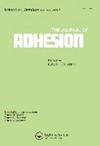Influence of printing material moisture on part adhesion in fused filament fabrication 3D printing
IF 2.3
4区 材料科学
Q2 ENGINEERING, CHEMICAL
引用次数: 0
Abstract
ABSTRACTFused filament fabrication plays an increasingly important role in modern manufacturing. Despite this, issues like deformations caused by thermal shrinkage are still common. These process failures, called warping, can easily be avoided by ensuring sufficient adhesion of the printed part to the build surface during the manufacturing process. Nevertheless, only a few is known about the factors which have an impact on the adhesion between a part to be printed and the build surface. Although the content of moisture in the used polymer plays an important role in every established processing method, its influence on adhesion is still unknown for fused filament fabrication. This publication investigates the influence of moisture in the printing material for the examples of build surfaces made from Pertinax and borosilicate glass and printing materials such as polylactide acid, polyvinyl alcohol and polyamide. These printing materials were characterized by thermogravimetric analyses and differential scanning calorimetry. Following adhesion tests showed that the moisture content of the printing material can alter the adhesion between the printed part and the build surface up to 68%. It was also shown that there is an optimum moisture content at which maximum adhesion is reached.KEYWORDS: Additive manufacturingmaterial extrusionbuild surface adhesion AcknowledgmentsWe would like to thank the working group of Macromolecular and Paper Chemistry of Markus Biesalski and especially Sunna Möhle-Saul for access to DSC and TGA measurements and consultation regarding setup and interpretation.Disclosure statementNo potential conflict of interest was reported by the author(s).Additional informationFundingThis work was supported by the Federal Ministry for Economic Affairs and Climate Action within the Central Innovation Programme for small and medium-sized enterprises (SMEs) under Grant 16KN084521.熔融长丝制造3D打印中打印材料水分对零件附着力的影响
摘要熔融长丝制造在现代制造业中发挥着越来越重要的作用。尽管如此,热收缩引起的变形等问题仍然很常见。这些过程失败,称为翘曲,可以很容易地避免在制造过程中,通过确保印刷部分足够的粘附到构建表面。然而,对于影响待打印部件与构建表面之间粘附性的因素,我们所知甚少。虽然所使用的聚合物中的水分含量在每一种既定的加工方法中都起着重要的作用,但它对熔融长丝制造的粘附性的影响仍然未知。本出版物调查了印刷材料中水分的影响,例如由比蒂诺和硼硅酸盐玻璃制成的建筑表面以及印刷材料,如聚乳酸,聚乙烯醇和聚酰胺。用热重分析和差示扫描量热法对这些印刷材料进行了表征。随后的附着力测试表明,打印材料的水分含量可以改变打印部件与构建表面之间的附着力高达68%。结果还表明,有一个最佳的水分含量,达到最大的附着力。致谢致谢致谢致谢致谢致谢致谢致谢致谢致谢致谢致谢致谢致谢致谢致谢致谢致谢致谢致谢致谢致谢致谢致谢致谢致谢致谢致谢致谢致谢致谢致谢致谢致谢致谢致谢致谢致谢致谢致谢致谢致谢致谢致谢致谢致谢致谢致谢致谢致谢致谢致谢致谢致谢致谢致谢致谢致谢致谢致谢致谢致谢致谢致谢致谢致谢致谢致谢致谢致谢致谢致谢致谢致谢致谢致谢致谢致谢致谢致谢致谢致谢致谢致谢致谢致谢致谢致谢致谢致谢致谢致谢致谢致谢致谢致谢致谢致谢致谢致谢致谢致谢致谢致谢致谢致谢致谢致谢致谢致谢致谢披露声明作者未报告潜在的利益冲突。这项工作得到了联邦经济事务和气候行动部在中小型企业中央创新计划(sme)下的资助,资助号为16KN084521。
本文章由计算机程序翻译,如有差异,请以英文原文为准。
求助全文
约1分钟内获得全文
求助全文
来源期刊

Journal of Adhesion
工程技术-材料科学:综合
CiteScore
5.30
自引率
9.10%
发文量
55
审稿时长
1 months
期刊介绍:
The Journal of Adhesion is dedicated to perpetuating understanding of the phenomenon of adhesion and its practical applications. The art of adhesion is maturing into a science that requires a broad, coordinated interdisciplinary effort to help illuminate its complex nature and numerous manifestations.
 求助内容:
求助内容: 应助结果提醒方式:
应助结果提醒方式:


